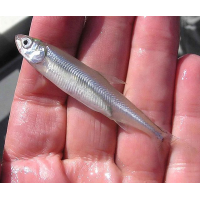Delta Survey of Once Dominant Smelt Finds Just One
 Delta smelt (photo: Peter Johnsen, U.S. Fish and Wildlife Service)
Delta smelt (photo: Peter Johnsen, U.S. Fish and Wildlife Service)
Scientists with the state Department of Fish and Wildlife (DFW) did not realistically expect to find very many of the once-dominant tiny, silver smelt in their April survey of the Sacramento-San Joaquin River Delta.
They found one.
That’s an 83% drop from March, when they found six. The end is near for Delta smelt in the wild. They were once the most abundant fish in the estuary. While they will be mourned, their passing will be accompanied by a certain horror at what the demise of this indicator fish means for the Delta ecosystem.
Smelt were a focal point of the fight over Governor Jerry Brown’s $24.5-billion Delta plan that pitted conservation and rehabilitation efforts against thirsty Central Valley farmers and Southern California residents. They were the poster child for short-sided neglect and awful water policy, and the vanishing canary in the coal mine warning of impending devastation.
Drought has not been smelt’s only enemy. They were subject to alien species, altered food supplies, water contaminants and water exports. Very little money was spent on Delta infrastructure and maintenance. So any protections afforded them benefit other Delta fish, like Chinook salmon, longfin smelt, green sturgeon and Central Valley steelhead.
Smelt have been around for millions of years. They thrived for hundreds of years after humans showed up, but the 20th Century laid them low. The smelt population declined by more than 80% in the early 1980s, before the fish was listed during a drought as “threatened” in 1993. The drought ended and their numbers increased for the better part of a decade. In 1996, Fish and Wildlife developed a smelt recovery plan.
It apparently didn’t work. By 2005, the population was 2.4% of what it had been 12 years before.
In March 2014, the U.S. Ninth Circuit Court Appeals upheld environmental protections for the smelt, which included controls on pumping of fresh water out of the Delta. The court ruled that the state must take “reasonable and prudent” steps to save an endangered species, despite the economic cost. The U.S. Supreme Court declined the appeal from the Metropolitan Water District of Southern California and from Central Valley farmers.
The court ruling did nothing to save the smelt, though it offered some hope to environmentalists fighting to preserve other elements of the ecosystem. How that plays out in future drought years, when thirsts grow, remains to be seen. Recent reports say the Brown administration has revised its plan for the Delta and plans to proceed with building two giant tunnels to convey water south, while putting habitat restoration on a separate track.
For now, the Delta smelt’s best hope for survival may very well lie outside the Delta—in giant fish tanks. The University of California, Davis, runs a hatchery in a laboratory south of Stockton and Fish and Wildlife runs a small backup hatchery below the Shasta Dam.
These refuge populations are the main hope for preserving the smelt’s gene pool. Most scientists don’t give the smelt more than two years in the wild. That’s a sad thought for some, but not for others.
“If the Delta smelt go extinct, in the short run that could improve the pumping operations of water for humans,” California Farm Bureau Federation attorney Chris Scheuring told the San Jose Mercury News. “It will free the pumps to start pumping a fair amount more.”
–Ken Broder
To Learn More:
California Drought: Delta Smelt Survey Tallies One Fish, Heating Up Debate over Water Supply (by Lisa M. Krieger, San Jose Mercury News)
Delta Smelt, Icon of California Water Wars, Is Almost Extinct (by Jane Kay, National Geographic)
Prepare for Extinction of Delta Smelt (by Peter Moyle, California WaterBlog)
Global Warming Threatens to Destroy Native California Fish (by Ken Broder, AllGov California)
- Top Stories
- Controversies
- Where is the Money Going?
- California and the Nation
- Appointments and Resignations
- Unusual News
- Latest News
- California Forbids U.S. Immigration Agents from Pretending to be Police
- California Lawmakers Urged to Strip “Self-Dealing” Tax Board of Its Duties
- Big Oil’s Grip on California
- Santa Cruz Police See Homeland Security Betrayal in Use of Gang Roundup as Cover for Immigration Raid
- Oil Companies Face Deadline to Stop Polluting California Groundwater





